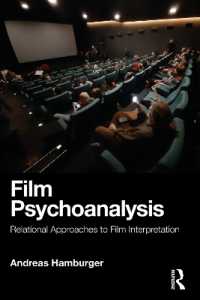- ホーム
- > 洋書
- > 英文書
- > Architecture
Full Description
According to urban academic myth, the first restaurants emerged in the wake of the French Revolution. From the very beginning in the elegant salons of the latter days of the Ancien Régime, the design of restaurants has been closely related to ideas of how food should be presented and how it may be consumed in public. The appearance and atmosphere created by restaurant owners reflects culturally embedded ideals of comfort, sociability and the good life. As a product of the modern metropolis, the restaurant encapsulates and illustrates the profound change in how its patrons viewed themselves as individuals, how they used their cities and how they met friends or business partners over a meal.
The architectural design of environments for the consumption of food necessarily involves an exploration and a manipulation of the human experience of space. It reflects ideas about public and private behaviour for which the restaurant offers a stage. Famous architects were commissioned to provide designs for restaurants in order to lure in an ever more demanding urban clientele. The interior designs of restaurants were often employed to present this particular aspect in consciously evoking an imagery of sophisticated modernity.
This book presents the restaurant, its cultural and typological history as it evolved over time. In this unique combination it provides valuable knowledge for designers and students of design, and for everyone interested in the cultural history of the modern metropolis.
Contents
Illustration credits. Notes on contributors. Acknowledgements. Introduction. 1. The Restaurant and the Rise of the Modern "Cuisine" Franziska Bollerey 2. The Restaurant: stage set and functional arrangement, the short history of an impossible typology Christoph Grafe 3. Food and cooking - an anthology of literary and other observations 4. Conditions for the Behaviour of Guests Hermann Czech in conversation with Wolfgang Kos 5. Puck, Pip and PS: the pursuit of pleasure, a designer's account Mark Pimlott 6. A selection of elements of the restaurant Bas Rozenbeek Case Studies 1. Restaurant Le Grand Véfour, Paris (1820). 2. Restaurant Le Grand Boulion Chartier, Paris (1896). 3. Augustiner Beer hall and Restaurant, Munich (1897-1898). 4. Midway Gardens Restaurant, Chicago (1914). 5. Grand Central Station Oyster Bar and Restaurant, New York (1904). 6. Theatre Restaurant Kroll-Oper, Berlin (1922-1923). 7. Bar-Automatique-Restaurant Presto , no. 1, Paris (1930). 8. Restaurant and Hotel Moskva, Moscow (1930-1938). 9. Gondolen Bar and Restaurant, Stockholm (1935). 10. Restaurant Savoy, Helsinki (1937). 11. Restaurant Meilongzhen, Shanghai (1938). 12. Cafés and Restaurants Roma Termini Railway Station, (1948-1950). 13. Restaurant Moskau, Berlin (1959-1964). 14. Grand's Restaurant, Philadelphia (1961-1962). 15. Boa Nova Teahouse and RestauranT, Leça da Palmeira (1958-1963). 16. Neal Street Restaurant, London (1972). 17. Restaurant Centrale, Beirut (2001). 18. Restaurant Belgo Centraal, London (1994). 19. Restaurant Flash, London (2008). 20. Le Lieu Unique Restaurant, Nantes (1998-2000). Select bibliography. Index.






